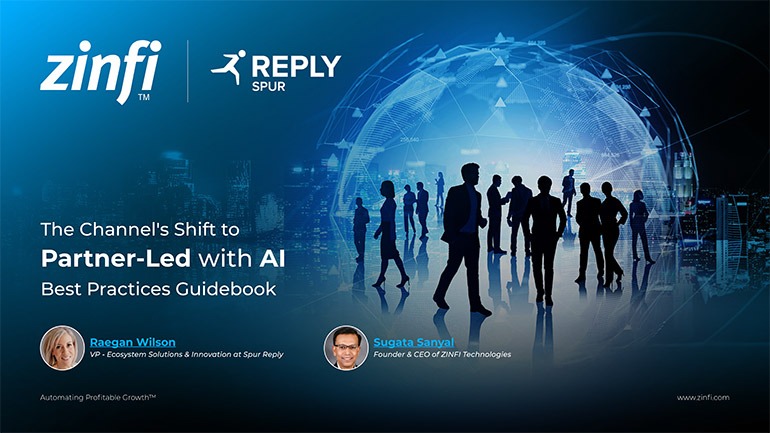Best Practices Articles

Should You Build or Buy Your Next Partner Portal?
If you have started reading this article, chances are you are looking to buy your next partner portal or build it internally. We face prospective buyers every day, some of whom grapple with this very question. Whichever option an organization chooses, it can be a struggle to justify the decision. Let me make an attempt to lay out a logical argument for both, and let you decide which line of reasoning makes more sense to you. However, let’s begin by establishing some context and describing clearly what a partner portal is. For the sake of our discussion here, I will use the term “vendor” to refer to the primary brand that is relying on a set of external organizations (secondary brands) to sell, support and service the its products or solutions.
Almost every organization today of reasonable size and complexity either has, or is considering, selling its solutions via an indirect sales force, either through a partnership with another large company or through partnerships with a diverse set of companies or institutions. Whether these co-selling entities are fully responsible for acquiring new prospects, selling and support or are engaged only in a part of these core activities- partner portal, they are participating in channel referral, sales or services activities. Nearly every vertical today has some form of a channel-based customer acquisition and product/service delivery mechanism in place. To successfully interact with this external set of partner companies, the organization selling or supporting via the channel needs a business portal that allows them to train the external organizations and keep them informed of all product- and service-related changes, improvements, commission structure, pricing, incentives, etc. This business portal has been traditionally called many things, including a partner portal, dealer portal, alliance website, agency portal, agent’s portal, wholesaler portal, extranet and more.
Most organizations have some kind of a basic business portal in place. Sometimes the portal is built internally using productivity tools like SharePoint . In many cases the partner portal is an extension of basic CRM infrastructure such as Salesforce, SAP and Microsoft Dynamics, but in other cases it is merely an extension of a company’s corporate website and associated infrastructure. However, in almost every case the application is not purpose-built for channel workflows and activities, and it fails to deliver a set of integrated tools that are designed specifically for partner recruitment, engagement, enablement and management. The majority of partner portal is also fail to provide deep analytical tools that can provide insight on various types of partner profiles and their productivity drivers. Furthermore, almost every one of these portals fails to deliver a set of integrated marketing and sales tools—apart from basic asset-sharing—that enable channel partners to market and sell the vendor’s product and services with the same level efficiency and effectiveness that the vendor itself would bring to those activities.
To complicate matters further: Since organizations are living and breathing entities that change on a regular basis to address market and customer needs, the way a vendor does business with its partner base necessarily changes on a regular basis. A static business portal made with a random collection of tools will completely fail to evolve and adapt to ever-changing business needs. This is why companies that have extended enterprise software from their direct applications—i.e., what they use for their own sales, marketing, finance and other functions for internal purposes—have failed to achieve success with partner organizations using direct tools. The shortcomings of a static portal lacking a full set of integrated tools designed specifically for channel marketing are what is driving many companies today to look for external solutions. These include purpose-built software like ZINFI’s Unified Partner Management SaaS platform that can fully automate the entire partner lifecycle from recruitment to engagement to enablement to management. I have written many articles about these activities, so I will skip the details here. However, assuming that you are aware of the importance of these channel activities, let’s now take a deep dive into the fundamental question we began with: Should you build your own partner portal? Or should you buy a purpose-built application like ZINFI’s Unified Partner management SaaS platform?
Now, before you conclude (understandably) that I am biased, let me make an honest case for the build scenario, because I do believe there are application areas where you might actually be able to build a partner portal better than what you can buy in the marketplace. What are these scenarios? I can think of five critical elements you must have in place to build and manage your own partner portal successfully:
- Channel workflow expertise –The purpose of all enterprise software is to automate business activities and transactions. To successfully automate your partner management activities and build a portal that addresses partner life cycle management, you should have the ability to map out various workflows related to your channel organization. If you are a vendor selling software through the channel, you may be able to do this.
- Software development capabilities –Once you know how to map your business workflows and create software development specification documents, the next thing you need is to have a team of software developers who can build your enterprise portal. You will need access to them not only to build the portal, but also to maintain it. As I indicated earlier, the portal will need to evolve on a regular basis.
- External outsourcing capabilities –If you don’t have a full-blown software development team but have a web team that has capability to set up your corporate website, you may be able to augment those resources by hiring external software development companies—onshore or offshore or both—to build your portal. However, in that case you need to have very strong program management capabilities to ensure these companies successfully custom-build to your requirements.
- Executive time –In addition to building out channel workflow, you also need a cross-functional team to meet on a regular basis to decide which parts of your portal you want to build out, why and how. This is a fundamental requirement: You should have a portal development and management taskforce that can provide constant oversight and determine what has to happen next.
- Budget –Last but not least, the most important consideration when building out your partner portal is to have sufficient budget so that you can finish what you start and, most importantly, keep it going. Building your own partner portal will require ongoing maintenance and development support, because inevitably different elements of the portal will require changing. It is very important that you have the budget not only to start, but also to maintain and operate. Otherwise, you will end up with an unfinished Mona Lisa.
If you have all of these five elements in place, then you are in a good position to venture into a partner portal development effort. In reality, however, very few organizations actually have all of these capabilities. Even if they do, they should also consider the benefit of buying technology that has been developed and tested dozens or even hundreds of times, as opposed to investing in a solution that you will be building for the first time. With that in mind, here are the five primary reasons for buying your portal instead of building it:
- Industry knowledge – Channel automation vendors like ZINFI build a technology platform that can address various workflows, from simple to highly complex. Every time we sell a portal to another customer, we gain valuable industry-specific knowledge. Every industry vertical is different. Even more important, every organization is different. While they all have requirements in common, many also have different or unique requirements. Our long-term access to a broad range of common and unique use cases has given us a depth of industry knowledge that your internal portal development team can never match.
- Scalable and secure technology – Very few organizations, as I mentioned above, have the software development expertise that can build highly scalable, secure and usable enterprise applications. We can all perform at our family Christmas dinner, but very few of us will play in Carnegie Hall. Writing enterprise software application requires deep expertise in scalable and highly secure technology platforms. Because of that deep industry knowledge developed over years, vendors like ZINFI can draw upon a highly competent engineering team with domain knowledge across many industries, as well as technologies that can address a variety of “corner case” applications.
- It works out of the box – Have you ever thought about building a car or house on your own? Yes, there are people out there who build their own houses and build cars, but they are hobbyists. The question you need to ask is: Can your business afford a hobbyist culture? Or do you want to buy something from someone who does it for a living, the same way trained professionals build a house or a car? Also, consider that the people who build thousands of cars and houses can source their material, labor and knowledge in a much more scalable way than you ever can. A $10,000 car that you can buy out of the box might cost you millions if you were developing it on your own—and, in the end, it might not be nearly as good as the $10,000 car.
- Continuous innovation – The beauty of SaaS applications is that as the cloud platform evolves, the technology that powers it also evolves. Companies like ZINFI that are in the business of developing SaaS applications are constantly learning, hiring, engineering and building what is next. This innovation cost is shared across thousands of users rather than a mere few, so companies like ZINFI can invest a LOT more in innovation to build out technology than a single organization can for its own use.
- Budget and time – I combine these two together, because for enterprises time is money. When you look at the five things you must do to build your own portal, it’s hard to justify it when you can get something out of the box and then quickly configure it to your specific requirements. When you do a cost calculation of building and maintaining versus buying and maintaining, the former is almost always going to be more expensive. And that calculation doesn’t even take into account the hidden cost of lack of innovation. While you are trapped into building and maintaining on your own, your competition may be using a state-of-the-art portal from ZINFI and getting miles ahead. In the end, speed of execution impacts both time and money, so you will need to consider that factor as well.
At the beginning of this article, I said I wanted to help you develop a logical rationale for determining whether you should build for buy. If you are Microsoft, Oracle, Salesforce, SAP, Google or another very large software company, then, yes, you have pretty much everything you need to build your own portal. However, if you are not one of these companies, you should seriously consider buying from a provider like ZINFI, which has been named a leader in partner relationship management (PRM) automation and through-channel marketing automation (TCMA) in recent Forrester reports. If you are still not convinced, please request for a free trial of our UPM automation platform. I also recommend you take a look this article in CIO magazine that argues it is usually far cheaper and faster to buy than to build. After all, if a problem has been adequately solved in a commercial product, why solve it again? Why not focus on a new and more interesting problem?
Hopefully, I have been able to provide you with a few more details and an analytical framework to figure out whether you should build or buy, and make a compelling case for one or the other.
Best Practices Guidebook
 Modernizing Channel Marketing: AI and Ecosystem Enablement Best Practices
Modernizing Channel Marketing: AI and Ecosystem Enablement Best PracticesDownload for FREE
 The Channel’s Shift to Partner-Led With AI Best Practices
The Channel’s Shift to Partner-Led With AI Best PracticesDownload for FREE
 Hyperscalers, ISVs, and AI: Shaping the Future of B2B Software Distribution
Hyperscalers, ISVs, and AI: Shaping the Future of B2B Software DistributionDownload for FREE
 Definitive Guide to a Partner Ecosystem-First Sales Strategy
Definitive Guide to a Partner Ecosystem-First Sales StrategyDownload for FREE
 The Partner-Led Digital and AI Transformation Best Practices
The Partner-Led Digital and AI Transformation Best PracticesDownload for FREE
 Startup Talent Recruitment: Hiring Missionaries, Not Mercenaries
Startup Talent Recruitment: Hiring Missionaries, Not MercenariesDownload for FREE
 The Future of Partner Relationship Management with AI in Partnerships
The Future of Partner Relationship Management with AI in PartnershipsDownload for FREE
 Cybersecurity for the 99%: Strategies from the Frontline
Cybersecurity for the 99%: Strategies from the FrontlineDownload for FREE
 Mastering Partner Relationships: A Strategic Approach to Business Growth
Mastering Partner Relationships: A Strategic Approach to Business GrowthDownload for FREE
 Mastering Partner Relationship Management: Keys to SaaS Channel Success
Mastering Partner Relationship Management: Keys to SaaS Channel SuccessDownload for FREE
 Navigating the AI Revolution: Guide for Partners in the Microsoft Ecosystem
Navigating the AI Revolution: Guide for Partners in the Microsoft EcosystemDownload for FREE
 Mastering the Modern Buyers Journey: Sales Leader’s Guide to AI & Engagement
Mastering the Modern Buyers Journey: Sales Leader’s Guide to AI & EngagementDownload for FREE










